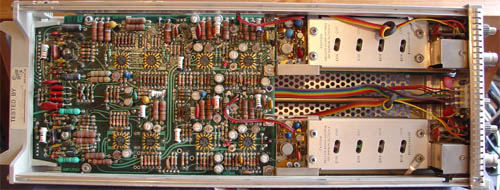The Ware for July, 2005 is shown below. Click on the image for a much larger view.
I hope that this month’s contest will be a little bit easier than last month’s contest. I’m a big fan of the type of equipment that this ware comes from, and this ware has a lot of interesting features and techniques that I learned through looking at it.
Bonus points for being able to identify the manfacturer and model number of this ware! I’m sure there’s someone out there who probably knows it right off the top of their head.

This is pretty easy although getting the exact model is hard. It’s a Tektronix dual-trace amplifier (although it’s possible it’s a differential amplifier). It plugs into an oscilloscope frame. It is two-channel and very analog (no ICs). I’m guessing it’s a 7A26, for the 7000 series frame.
http://www.inxs-inc.com/cgi-bin/menu.cgi?a=view_prod&id=429
I agree with Nate that it’s a plugin module for a Tektronix modular
oscilloscope. I’m guessing a 7A26 dual vertical amp. This accepts
signals from the scope probes and scales them to an internal scale for
use by the scope electronics (presumably +/- 15V from screened
comments, though maybe). Another module in the scope mainframe would
provide the horizontal timing and triggering signals to gate the
electron beam in the display tube.
Big hints from the zoomed-out view:
High frequency section in RFI shield cans.
BNC connectors and knobs visible on the far right side.
Spring fingers on the right side suggest that this plugs in to
something bigger, as does the substantial casting on the left side
Then, when you zoom in, the “Tek” on the ICs and the “Tested By
Tektronix” label are giveaways.
Web resources of note:
This picture of the innards of a 7A26 looks awfully similar to yours:
http://www.amplifier.cd/Test_Equipment/Tektronix/Tektronix_7000_series_amplifier/amplifier_7A26.htm
However, the page on the 7A24 (Nate’s guess) suggests that the 7A24 is
very similar except for a higher bandwidth and lower input impedance,
so it may have an extremely similar layout. I’m guessing that you
have a 7A26 because it’d be more useful.
According to http://www.caip.rutgers.edu/~kahrs/testeq/ics.html all
the ICs visible on this side of the board are vertical amps.
Other features of note:
High density for a through-hole board.
Hand-laid-out traces
Many, many trim pots. This was not a cheap board to calibrate.
What are the white plastic components with color codes
hand-painted on them? Hand-trimmed resistors?
Serves me right for posting too early. I erroneously besmirched Nate’s (correct, AFAIK) guess and didn’t mention anything about the funky circular IC packages for the vertical amps. Why these instead of, say, DIPs? Increased density?
Might also be a 7A18.
It’s not a 7A18 or 7A18A, and it’s not a 7A24. The tip-off is the two DPDT switches; David has it right, it’s a 7A26.
See also:
(7A26) http://www.inxs-inc.com/cgi-bin/menu.cgi?a=view_prod&id=429
(7A24) http://www.inxs-inc.com/cgi-bin/menu.cgi?a=view_prod&id=438
(7A18A) http://www.inxs-inc.com/cgi-bin/menu.cgi?a=view_prod&id=8102
— Terry
Hi Terry, haven’t seen you around FreeBSD lately. In any case, as you can see, I did say 7A26 and even gave the same link as you for it. :)
B100 can be used directly in most diesel engine applications. ,